2010 USA Open
Class Nationals
Dave's Blog from
Hobbs, New Mexico
Last Update: Tuesday AM, 13-July-2010
Prologue
Hobbs is home of the Soaring Society of America, and the site of
many classic races over the years. This year Hobbs is concurrently
hosting the Open
Class and Standard Class nationals. The race is being organized by
volunteers from all over, assisted by some of the SSA staff
after-hours. We're looking forward to big skies, massive thermals, huge
distances and high speeds. Not like Ohio. Edre Maier is competition
manager, and Rick Sheppe will be the Competition Director. Last time I
raced here was 2006, just before I got my current glider (Dave's blog from
2006 Hobbs race).
I'm racing my Antares 20E electric-powered glider, using the
20-meter wingtips. Open Class rules permit changing tips on a daily
basis, but I think
the 10.7 lb/ft2 or so max wingloading with the long tips will be
adequate for Hobbs weather, so I won't use the 18-meter tips this
contest (which would push me up to 11.4 lb/ft2 max). The big guns are
here: Dick Butler flying
his Eta-Biter (arguably the best open class glider in the world, until
Dick's Concordia flies), Ron Tabery with an ASW-22, and many
others.
Getting there is half the fun (NOT)
Left Ohio mid-day after the last day of the 18-meter nationals was
scrubbed, and made good time, hoping to reach Hobbs Friday evening.
Passing through Oklahoma City, I saw in my rear-view mirror the top of
my trailer detached at
the left front and sticking up in the breeze. Not Good. Pulled off the
highway and found a repair shop willing to give me a hand. The
clam-shell trailer top hinges at the front of the trailer, and the
hinge pins are secured to the top with two bolts on each side
(the same bolts that hold the external handles on the front of the
trailer).
One of these bolts sheared, and the entire left side of the trailer
top was shortly waving in the breeze. Not Good. After 2 hours repairing
the trailer, got back on the road. Made it to Lubbock Texas late Friday
and called it a day.
Trailer top sticking up in the breeze - Not Good.
The rear trailer latches were insufficient to keep the rear closed no
the left side once the hinge failed, so the left rear was open and
unattached as well (not as high in the air as in this photo, taken
after the right rear was unlatched). The sheared bolt is where handle
is loose on the front of clamshell top. Extremely lucky I had no damage
to the glider.
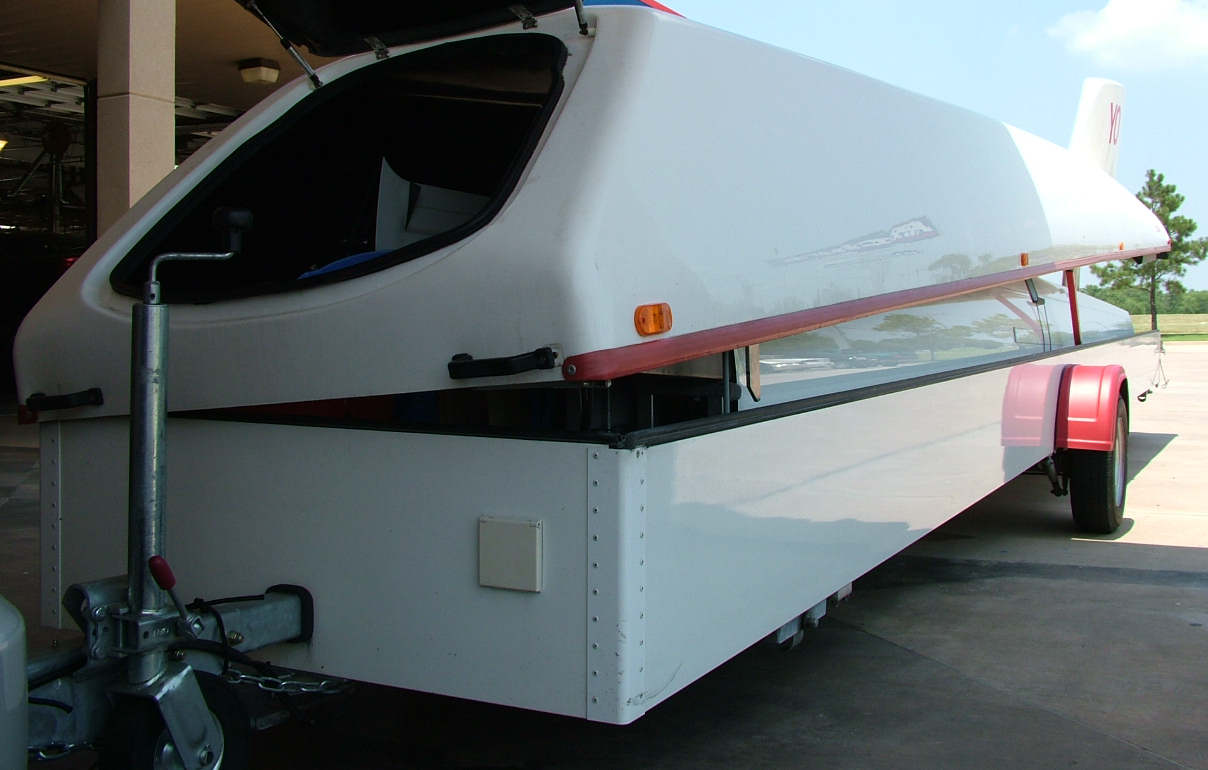
Thanks again to the folks at
Richards Car Care (14827 North May Avenue)
for loaning me a few tools, directing me to the nearest hardware store,
and wrestling the top down into position so I could insert the
replacement for the sheared bolt. They wouldn't even charge me for the
help !
So I bought a crate of assorted cold sodas and passed them out in the
hot shop
before getting back on the highway.
Please Note: Many you have
emailed asking for info about this Cobra problem. Alfred Spindelberger
advises they've never heard of this happening before. I'll post
something further after I've discussed it in more detail with Alfred.
Do not remove the
hinge mounting bolts without firmly securing the trailer top, otherwise the
gas
springs will push the top upwards and you will not be able to replace
the bolts...
Saturday June 26
I pulled into Hobbs in the morning, to a chorus of "Dave ! You
shoulda been here yesterday ! Best Day of the year ! No storms like
forecast for today !" Huh ? Storms ? Never mind, put the Antares
together, long wingtips for a change, and get ready. Beautiful clouds
beckon, can't hang around waiting for a tow plane, so I blast off under
my own power. What a pleasure to take off from a dry surface, rapid
acceleration and liftoff without plowing a furow and spraying a wake of
water like from the muddy Caesar Creek airfield last week ! Shut down too soon, fell out, did a quick boost,
and presently was climbing at up to 9 knots, to over 10,000 feet. We're
not in Ohio anymore.
Quick run up to the north-west corner of the task area, turned at
Kenna, headed south and its already raining on Tatum. Beautiful strong
clouds, up to almost 12,000 feet, running at 110 knots, this is more
like soaring ! Steered west of the rain, past Hobbs, southbound over
Eunice, then Wink, then south-east to Monihans where Mark Keen in 7K
joined up with me. I was hoping to make another run north but the
storms were becoming vigorous and approaching Hobbs, so we ran the
shelf in front of one of the storms and screamed back to Hobbs at max
warp. Nice quick 550km (330 mile) warm-up flight. Shoulda
come back a bit sooner and not delayed putting the plane away, because
the gust front hit with 40mph gusts as I was putting it in the trailer.
Thanks to the MASA guys for helping me steady it and get the
trailer closed in the wind. Some guys had minor damage from the gust
front, my plane is
fine but my glasses blew off and got well-scratched tumbling down the
ramp.
Saturday's
flight on OLC
Looking west through a gap in the storms, at around
11,000 feet under the storm shelf. The gust front on the ground is
visible in front of the rain shafts - that's a lot of air and energy
sucking up into the cloud..
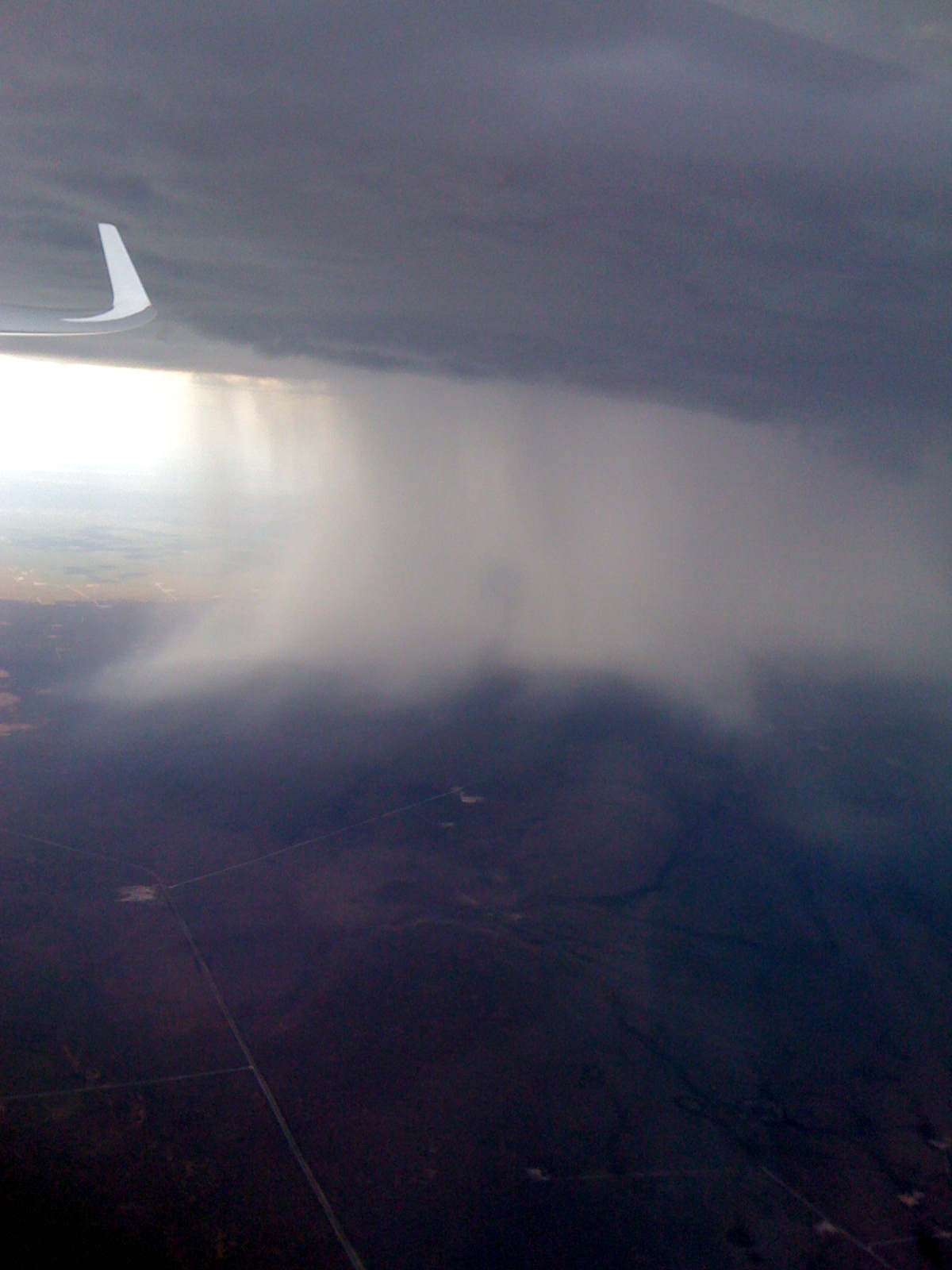
YO is in Hobbs !
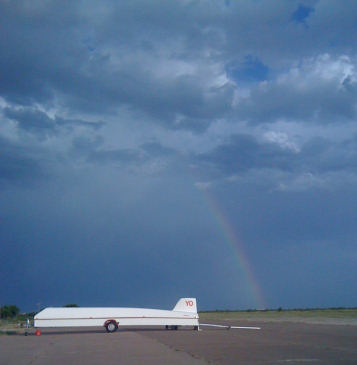
Sunday June 27 - Practice Day 1
Today dawn showed lots of high blow-off from yesterday's storms.
Don't need to look at a weather forecast to know what this means:
lots of moisture still aloft, so we'll have storms later.
This was confirmed at briefing by remote weatherman Walt Rogers.
It stayed overcast for a while, a couple guys launched and quickly
returned after they had a good look at developing storms around us.
I took advantage of the shade and washed the trailer and car...
Tomorrow's forecast is for increasing moisture and storm threat, so
perhaps I can wax them as well.
Monday June 28 - Practice Day 2
Today dawn showed lots of high blow-off from yesterday's storms.
Don't need to look at a weather forecast to know what this means:
lots of moisture still aloft, so we'll have storms later. Oh No ! Same
as yesterday !
CD Rick Sheppe has arrived, a nice looking cu field has already
developed to the north before the 10AM pilot's meeting, but there is
still quite a lot of moisture aloft, and those bases are low.
Yesterday's weather map showed a line of thunderstorms stretching from
New Mexico all the way across New York and touching western
Massachusetts. Briefing commenced with 20 minutes of technicians trying
to get GoTo Meeting working for the weather briefing. Tom Kelly says
"After you weigh, go back in the box". Finally weatherman Walt Rogers is live over
this new-fangled internet thing !
Walt says the upper air disturbance will hang around for the next days,
gradually moving east. 3PM cloudbase of 7500 MSL - we're at 3700MSL on
the ground. Scattered to numerous thunderstorms in the task area, worse
to the southeast. Lift 2-3 knots except much much higher along storm
gust-fronts ;-) Local flying may be possible, but stay close
because of the storms...
I got an oil change, got a hose and scrub-brush and blasted the Ohio
mud out of my landing gear, waxed the front of my car, and the sky kept
looking better and better. No towers out of the cu anywhere on the
horizon;
apparently the sounding was wrong. Stopped waxing, rigged, and blasted
off into good lift with bases around 9k. Definitely not as forecast,
with better lift and also a 25 knot wind, but cloud base a bit low by
Hobbs standards. I headed towards Morton as there was a good line of
clouds with great and predictable lift to 9k, until I reached a
gigantic blue hole. Found some odd wave lift and climbed briefly above
the clouds, but couldn't make sense of it, and crossing the blue to
Morton seemed unwise. Bailed east towards clouds near Plains, and
presently I thought I was back in Ohio. Low cloud bases, water standing
in the fields, weak lift, and windy to boot.
Dribbled back to Denver City, where it is always lousy, and it was
lousy today. Clouds looked great down south, so I headed to Hamilton,
and turned east to Seminole. Got low in another hole.
There was a storm building south towards Andrews, already with some
thin rain shafts, so I started down the edge of the storm thinking I'd
follow it southwest to Jal then home, thereby avoiding the blue hole on the
direct route back.
But the mandatory meeting is this evening, so after running the storm a
few miles I turned homewards and
struggled across the hole to better lift and on home. Didn't see any
other gliders as everyone started early and had gone to dinner when I
landed. A few folks had nice flights around the close-in turnpoints
(and why was P7's trailer going down the ramp as I disassembled ?).
Anyway, good to get a few nice hours of soaring, around 150 miles OLC,
my Antares is back in the box charging, and even got to the meeting on
time.
Tuesday June 29 - Race Day 1 ?
Today dawn showed lots of high blow-off from yesterday's storms...
Plus low cloud and light sprinkles of rain during breakfast. TV weather
has flash-flood watches for nearby Odessa and Midland counties in
Texas. Pete Alexander cheerfully proclaims "Ohio, Take 2 !". Its
raining lightly as the pilot's meeting is about to start, and I didn't
rig in the rain... Day scrubbed at 1PM after enough rain to leave the
ground well soaked. Gary suffered a landing gear collapse in an
otherwise
routine off-field landing on Monday, so rather than mess with sorting
out the
gear he's changed classes and will fly his '29 in open class (he
brought both his Discus 2 and ASG-29 to this contest). See honey, this
is why we need those spare gliders, like I've been telling you. Nice
lasagna dinner and social at the airfield in the evening, with gorgeous
storms just to the south illuminated by the evening sun, and
less-gorgeous storms to the north, east, and west...
Wednesday June 30 - Race Day 1 ?
Today dawn brings low overcast in all directions and light rain.
Plus sporadic very heavy rain. Weather prognosis looks very bad.
Rick suggests we take a trip to the Silent
Wings WWII glider museum in Lubbock. Day scrubbed. Mark Keene
and son Austin, with Ron and Gena Tabery and son Julius, are off to
Carlsbad Caverns. Bunch of guys headed out to Silent Wings, but I'm
going to work a bit. Lovington (city up the road from Hobbs) is
advertising their July 4th festivities, whose highlights include the
cow-pie throwing contest and the lizard race. Bring your lizard on
down, you could be the big winner.
Thursday July 1 - Race Day 1 ?
Today dawn brings low overcast in all directions and light rain.
But a brief bit of sun poking through. There's a very brief window
where maybe we could fly a short task this afternoon, though we're
certainly not going to get above 4k AGL and we'd likely be dodging
showers. Grid time is 1PM. OK, we grid, we wait, we are treated to
refreshing sprinkles but no drenching, sniffer launched, sniffer lands,
nice social time on the grid (Julius ran the Antares motor), sniffer
launched... CD Rick Sheppe finally cancels Open Class (back class on
the grid, out of time), and launches the Standard Class. They stick,
but not sufficient altitude for a safe and fair contest - task
canceled. Unlike Ohio, we need some reasonable altitude as the landing
spots are few and far apart. Some guys went out anyway (we're getting a
bit stir-crazy not flying), "16" landed on a road 7 miles out of
Hobbs. Next couple of days look hopeless with heavy rain, DB even
put his glider back in the trailer. YO is back in the trailer as well,
but that takes me less than 20 minutes !
6PM social and dinner at the hangar - nice barbecue ! And now
the rain begins in earnest...

Standard class gaggle Thursday.
Not very high !

View down the ramp a couple hours later...
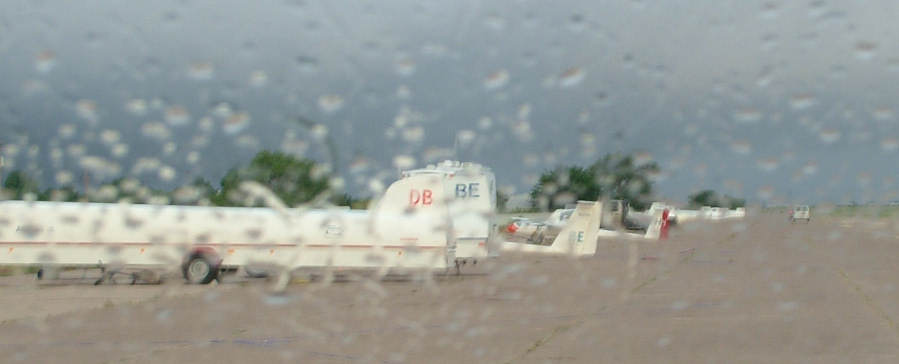
Maybe Sunday we can fly, but not before.
Friday July 2 - Rain Day
Rain, flooding, flash flood watches, you get the picture. Fantastic
amounts of water are pumping into the area, outflow from hurricane
Alex. Weatherman Walt Rogers says he has never seen this level of water
saturation in the atmosphere anywhere (ground up through 25,000 feet),
let alone someplace like Hobbs. Sunday is possible, Monday through
Thursday more likely.
Rick Sheppe gave a great presentation on the FAI and IGC structure
and rule-making process. We all owe Rick thanks for his hard work as
our IGC alternate-delegate. Rick is working hard to improve the
competition and badge rules.
Saturday July 3 - Rain Day
This morning I went to do some errands in Hobbs, and found street
flooding. Today isn't officially canceled until later, but heavy rain
and
flooding make it unlikely.
Parts of North Dal Paso street are under water.
This car got drowned before the police closed this segment. Picture taken with my iPhone.
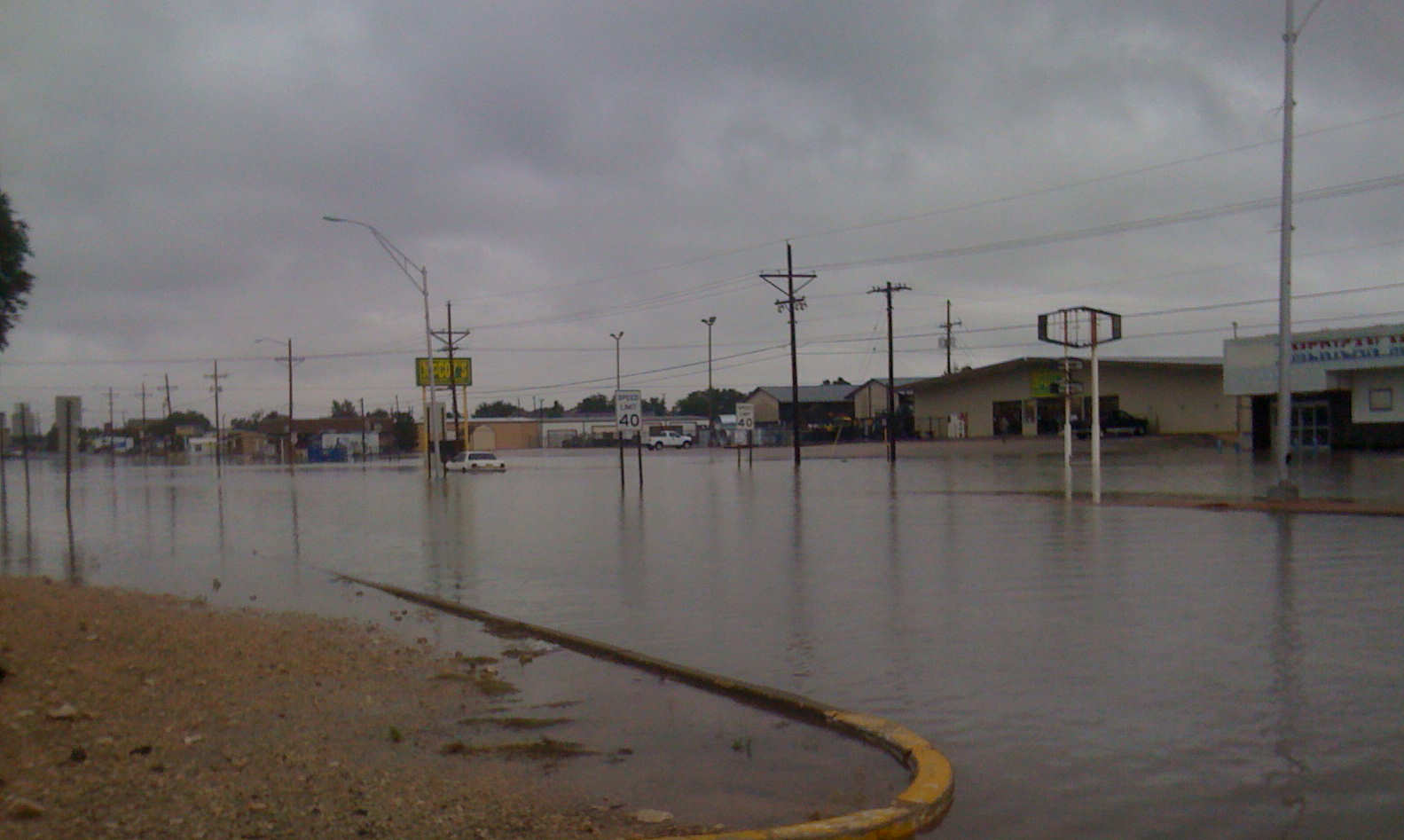
Weatherman Walt Rogers again shows us a completely saturated airmass up
through 25,000 feet. No chance today. Sunday possible, Monday through
Thursday look flyable as the moisture slides to our east. We have to
fly 4 days to get a contest (and there are other requirements to get in
a contest regarding task completion by highly-seeded pilots).
Rick Walters briefed us on Maljamar airport - don't try it except
with a 15-meter or shorter-wing glider, and watch the farm implements
on the runway... Rick Sheppe and Andy Durbin briefed us on "Abandoned"
(old auxillary B-17 training strip) - still has one taxiway landable
but watch out for a few mesquite trees growing up through the pavement.
After our briefing this morning, I gave a presentation on FLARM.
This included an overview and a description of the PowerFlarm unit
coming to USA.
I also showed a video presentation of the midair last week in Parowan.
The video shows the
two flight tracks animated with SeeYou, and two flarm units
displaying cockpit info in sync with the SeeYou animation.
Its clear the pilots would have
had plenty of warning to avoid the collision. Very Impressive. Too bad
they didn't have flarms, with which they would not have had this midair.
Sunday July 4 - Race Day 1 !
From the AM weather radar,
the heaviest rain is now to our east, on a line north-south through
Lubbock Texas. There are a few breaks in the clouds, with low ceilings
and sprinkles. The Lovington Independence Day festivities, originally
scheduled for yesterday, are rescheduled for today. The Great Lizard
Race is at 4PM. More competitors have left so we're down to 22. Social
with hamburgers at Zia RV Park this evening. Dave Springford briefed us
on the landable road 7 miles out and gave us coordinates for our flight computers.
Weatherman Walt Rogers confirms that the very heavy moisture plume
is a
bit east of us, from Fort Stockton through Midland and Lubbock. 4PM
thermals to 5,500 feet MSL or maybe 6,600 feet, but remember we're at
3700 on the ground. Airmass is pretty stable, subsidence and drying,
but any heating may bring showers. There's still a flash flood watch
for the next 24 hours in our area, as any precip will immediately cause
flooding with all the water still on the ground. Another model shows
higher bases and some clearing after 3PM.
CD Rick Sheppe has given us a 2 hour MAT expecting that in the
unlikely event we go it will be a short day. 1PM grid time.
Good looking cumulus clouds at grid time, but extremely low
cloudbase make it look pretty dubious. I gridded without taping - hate
to wast the wing tape ! Sniffer Tom Pressley launches in his classic
ASW-15 and sticks, and as bases gradually rise above release altitude
Rick Sheppe starts the launch. I apply the wing tape, self-launch, and
find a nice thermal right over the ramp and shut down at 1500ft (this
uses 15% of my battery power). Rick waits to open our task as the bases
are variable and too low over Hobbs, but adviser Mark Keene reports a
whopping 6900 feet (3200 AGL) out towards the mandatory first turn of
Lovington - the game is on. There's a line of clouds headed from over
Hobbs to Lovington, but with bases down under 3000 AGL, but further
west is another line with higher bases. Down south bases are lower, and
before start I could see a storm building with cloud almost down to
ground out east of Seminole. I wait in the western part of the start
cylinder with a bunch of guys until I can't stand it anymore and head
out. Should have waited to have a few markers in front. Quick run to
Lovington (which after all is practically in the Hobbs traffic
pattern), and shortly Chip Garner CG and Mark Keene 7K are with me. We
press from Lovington towards Caprock or Tatum following a good-looking
line of clouds, but they were nasty evil lying clouds and didn't work.
I finally break off and head towards a good-looking field, and catch a
thermal as I turn base (Antares is still a glider - I was reaching for
the power lever as I set up the landing pattern). What a struggle. Got
up and dribbled into Tatum, stayed with weak lift over the turn to get
all the way back up to 2900 feet AGL, and headed south to Abandoned as
the clouds looked better. I'm on track for a 2 hour return to Hobbs
with an average speed below stall ! Can't have that, so I stayed out
another hour, back to Lovington, down to Eunice, and return home an
hour after everyone else. That pulled my speed back up to an amazing
48mph. Dave's
Day 1 flight on OLC.
Dick Butler wins in open class, heading west after Lovington and
staying in an area of good lift Hagerman-Railroad Crossing-Maljamar and
home, for almost 67mph. In standard class Biff Huss stayed close in and
in good lift for 65mph - after almost landing out after his first start
Biff came back and did it right. Former national champion Chip Garner
got low near me and managed only 37mph, and former national champ Ron
Tabery also got in trouble and turned in 45mph. Tough day. First timer
to Hobbs Pete Alexander told me his briefing for Hobbs was never, ever,
ever get below 9000 feet - and here we are flying a task with highest
bases just above 7k !
Monday July 5 - Race Day 2 !
Dawn brings low cloud but no rain (except south near Eunice), and
much higher moisture levels on the same line east of us. The overcast
is breaking up as the pilots meeting starts. Walt Rogers briefs us
about a convergence dry line line west of us later today with much
better lift (Carlsbad - Littlefield, best lift west of Portales), and
near Hobbs we should have higher bases than Sunday. Rick says we will
probably have a 3 hour Turn-Area-Task, grid time at noon, pilots
meeting at the grid for the task. One more standard pilot has fled the
scene after landing out yesterday at Abandoned.
Well, this day was a bit "interesting".
I self-launched and shut down at 1400 ft AGL in a nice thermal right
over the ramp. At 2000, the climb stopped abruptly with a hard
inversion - not shown in the sounding we saw during the weather
briefing. Some thermals weakly poked through the inversion a hundred,
maybe two hundred feet. It was fully two hours after launch before I
saw 3000 ft above ground. The advisors and CD ruminated, reviewed
different task ideas, listened to pilots whinging on the radio, and
eventually called a MAT with a mandatory first turnpoint of
Intersection. Intersection is straight east of Hobbs, and well into the
moisture plume we've been watching for the last few days. Also, the
start cylinder was moved from the south start area to over Hobbs.
Unfortunately, I was at the far end of the original start cylinder (perfectly positioned for the original task), and
had to fly around 8 miles and climb back up to start, which is how I
ended up last to start with no markers in front. A convergence line
between the western drier high-pressure airmass and the eastern
moisture plume ran roughly north-south a bit east of Hobbs. After start
I climbed up to 8k near Hamilton, and topped off again at 8k half-way
to Seminole, now thousands of feet above the clouds to the east. It was
clearly a survival game, hold on to absolutely as much energy as
possible, duck under the overcast, nick the turn, and try to glide back
out to sunshine and lift. No markers in front, though I was briefly
with Mark Keene in 7K. Mark took a direct line, but I saw a line of
blue that would allow me to glide above the clouds closer to the turn.
70 knots, patience, skirt a towering cu and try bounce any shreds of
rising air and fly efficiently... And eventually duck under the gloom
and coast to the turn. As I turned Intersection at 1500 feet AGL (4700
ft MSL) I dumped my water ballast, and headed for sunshine and shreds
of lift. Saw 7k flailing low about to land. Bounced some lift for 100
feet, lost it, kept going, and finally connected with a thermal at 750
ft AGL halfway back to Seminole airport, which took me back up to
2500ft AGL. Followed a line of wisps over Seminole airport, after which
there was a big hole. Max LD to Hamilton where the convergence was
marked by a big stepped cloud, and where I connected to the lift at
1400 ft AGL and gradually worked up. The great looking cloud only
yielded 2.5 knots for which I was extremely grateful.
Tactically there was no choice what to do - the convergence line,
with higher cloudbase and guaranteed lift, ran to Eunice. I went to
Eunice, over the 2 hour target time but needing to pull up my average
speed in the better soaring conditions to the west. Bumped along the
convergence, which had no strong lift, topped out under an isolated cu
near Eunice at 9k. Looked at continuing south to Jal but it looked
risky - possibly the turn was on the wrong side of the convergence. So
I hooked back under the lift line and flew home at high speed. Could
have made a few more points flying slower and making a tiny triangle
around Hobbs as did a couple Open Class. 5 open class finishers, yours
truly slowest. Dick Butler wins again, with Ron Tabery very close
behind. Ron probably lost a few seconds admiring the Peregrine falcon
he circled with for a few turns. Pete Alexander and Steve Leonard made
it back to Hamilton and landed there, annoying the crop dusters. Gary
Ittner and Sam Zimmerman landed in fields near the turnpoint. Dave's
Day 2 flight on OLC (low point not as exciting as Sunday)
Standard class got massacred. Chip Garner, slowest finisher the
prior day, was the only finisher. No contest day for Standard class as
Chip was the only pilot to make the minimum scoring distance. We
scattered gliders everywhere, all safe without damage.
SSA staff has been doing retrieves ! I volunteered to go fetch
someone after I landed, but all land-outs had crews already on the
road. Nothing to do but enjoy the excellent USA team fund-raiser wine
and cheese party.
Tuesday July 6 - Race Day 3 ?
Dawn brings low cloud to the south-east, which moved over us well
before our pilots briefing.The IR satellite time-lapse shows moisture
moving in our direction, and radar shows light rain east of Seminole.
Walt Rogers thinks the cloud over us will burn off, without the
inversion that held us at 2k for 2 hours yesterday. Rick says expect a
turn area task, we have no clear view as to what quadrant will be best
(or even plausible). Pilots meeting at noon at the head of the grid to
get the task. We'll see...
On the grid at noon, there's a shelf of high cloud over the airport,
with sun just to the north. Rick launches the standards to the north,
but they struggle. Open is launched south to lower clouds building
under the overcast, where we find OK lift but again very low bases.
Task is held as the cloudbase gradually moves up, and several task
iterations are reviewed. Eventually standard has an assigned task of
Hamilton, Abaondoned, Lovington, and return. Open gets a short 1:30 MAT
with a mandatory first turn of Hamilton and a mandatory steering turn
just north of the airfield to ensure we're all finishing to the south.
An hour 20 minutes after launch, I started at the upwind side of the
cylinder at cloud base (only 3200 AGL) with a line of clouds to
Hamilton. Unfortunately the clouds evaporated and I shortly was at 1600
feet over Hamilton. Climbed back up a bit then followed a line of
clouds direct to Abandoned, climbing slowly under the street until a
whopping 3 knot core. There was sun on the ground and a street to
Denver City, so I chose that over Lovington - big mistake. The street
died as I reached Denver City, and I struggled west as the wind
increased and the clouds all vanished. Had to use my motor - scored as
a land-out after 65 miles.
Dick Butler wins his 3rd
consecutive day for a whopping 470 points given the extreme devaluation
of our short task. Dick got in and out of Denver City before the lift
died,
then did Hobbs, Lovington, home. A couple open ships returned with less
than minimum
distance. Standards made it around, Chip Garner winning. Dave Greenhill
was scored as .39 miles short of minimum distance, which drew a protest
as the CD had announced nicking each cylinder was good for minimum
distance. Hopefully he'll be scored as 60 miles (rather than a canceled
day, which would yield a rain-out for the standard class).
Despite
my blunder I'm still in 4th overall (5th including foreign guest Brian
Milner).
Looking down the ramp at a nice sunset with storms north of Hobbs.

Wednesday July 7 - Race Day 4 ?
Dawn brings a bit of high level and some mid-level cloud, clearing
by pilots briefing. There's light rain 40 miles southeast out by
Andrews. Hard to have confidence in the forecast after the past few
days, and especially as we seem to be in an area between different
colliding airmass without distinct fronts and motion. The sounding shows an
early inversion around 7k but 2-3 knot thermals by noon to 1PM.
Cloudbases 5k AGL up to 7k by late afternoon with stronger thermals.
Walt Rogers thinks today will be the best day of the contest - which
wouldn't take much... 50% chance of rain tonight and Thursday.
11:30AM we're having a Tarantula race on the grid. CD Rick Sheppe says
expect a turn-area task to the north. Sniffer launch at 12:15, grid
time 12:30 with pilots meeting at the grid. Time to go load up the
Antares with water ballast.
The Tarantulas scampered in all directions. It was mayhem.
They didn't like the hot ramp (can't blame them)
and chased shade (from humans).
This behavior wasn't figured out in advance - could have been
used to get them going in the same direction.
After lots of scampering the cute furry critters were retrieved
from the ramp.

By grid time it was clear we were going to have problems. There were
storms in the distance and it was clearly going to overdevelop with
widespread storms. Rick gives us a turn area task which sends us north,
south-west down to the west of Hobbs, back up north, and home. Standard
launched first and quickly left on task. Open class launch was
fouled up with tow-rope breaks, knots, then towing us under rain (not
sure why competitors didn't firmly direct the tow pilots to head away
from the rain, you know, safety and VFR and all that).
View from the ramp before launch.
It was already raining to the west (the second turn area of our task).
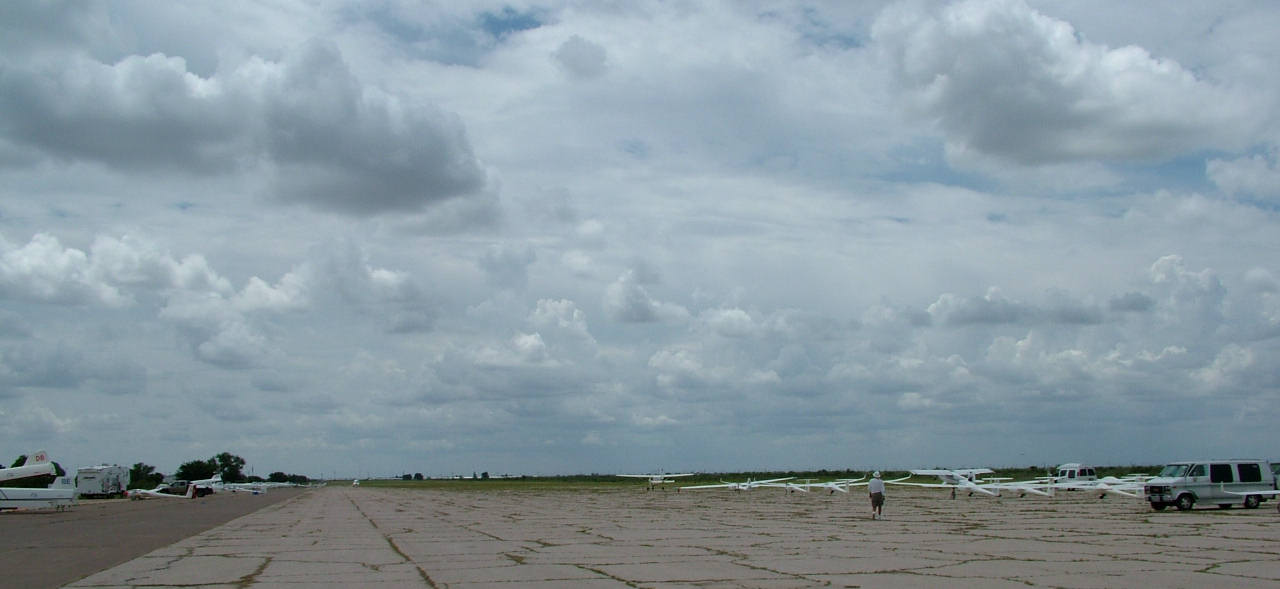
View from the cockpit just after launch; rain
just south of Hobbs.
Those square clearings on the ground are pads for oil derricks.
Sorry about the task sheet reflection on the canopy.
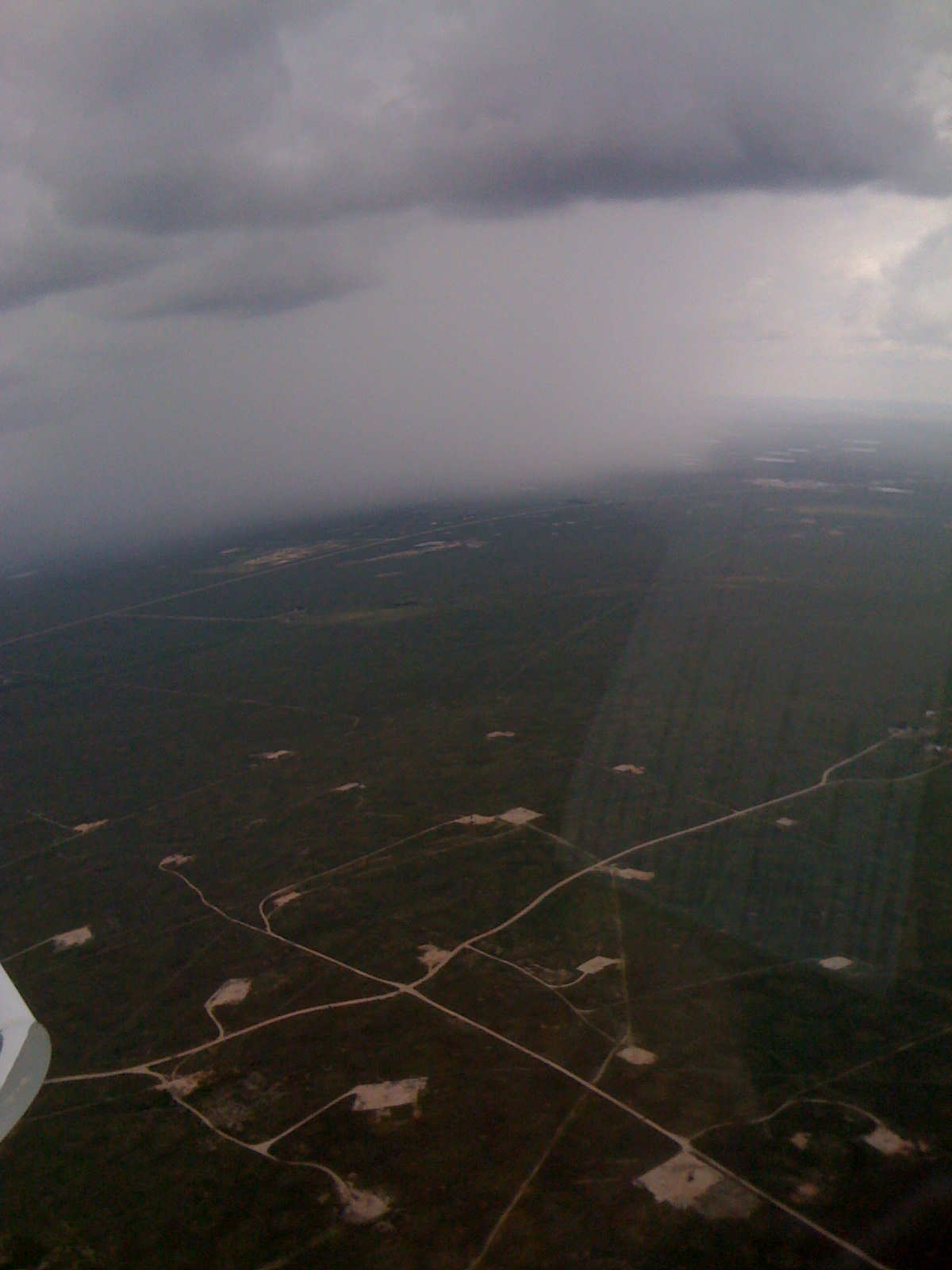
Open class task opening had to be delayed to give the
last to launch time to fly out of the rain and then climb up from low -
while the storm and rain is overtaking the airfield and pushing us out
of the start circle. Finally the gate is opened and we head out, 40
minutes after the standard class - way too late for a reasonable
chance.
I didn't get a clean start, got rained on flying back in and out of the
start cylinder (by now its raining at Hobbs and through the entire
5-mile start cylinder). Promptly I'm down at 1000
feet above Lovington, lost track of the other gliders except one
circling well below me (JP, eventually landed in a field). Got up
slowly and followed the clouds north
into the first turn circle, slowly. There's a lot of rain in the second
cylinder, but it looks like I can fly west of the storms and just nick
the western edge of the cylinder. After turning at Crossroads, I ran a
storm shelf towards a gap in the storms - until it was starting to rain
about 15 miles from the edge of the cylinder. There was a wall of water
ahead - not smart to try penetrate that rain to the turn area, and then
come back through it again to the
north, all over very bad terrain without decent landing options. Not
for me. I aborted
the task and ran the shelf back north, intending to land at Tatum
(still in sun between storms). As I got to Tatum there's an opening
between the storms back to Lovington, so I glided south and landed at
Lovington in light rain (collecting my 25 point bonus for landing at an
airport without using the motor). Taxied to the ramp where I found Chip
Garner, Pete Alexander, and Bob Epp. Waited for the rain to
stop, dried the Antares, taxied out, took off, and flew home to Hobbs. Dave's
Day 4 flight on OLC
The outflow from these storms sometimes forms convergence lines.
After shutting down the motor on the way home to Hobbs, I found a
convergence line from Lovington city to near Hobbs. I couldn't
help but climb in the convergence and snap some photos. Note the cumulonimbus tower in the background. Finishers Ron
Tabery, Mark Keene, and Dave Greenhill all found this convergence and used it to return to Hobbs
earlier in the afternoon.
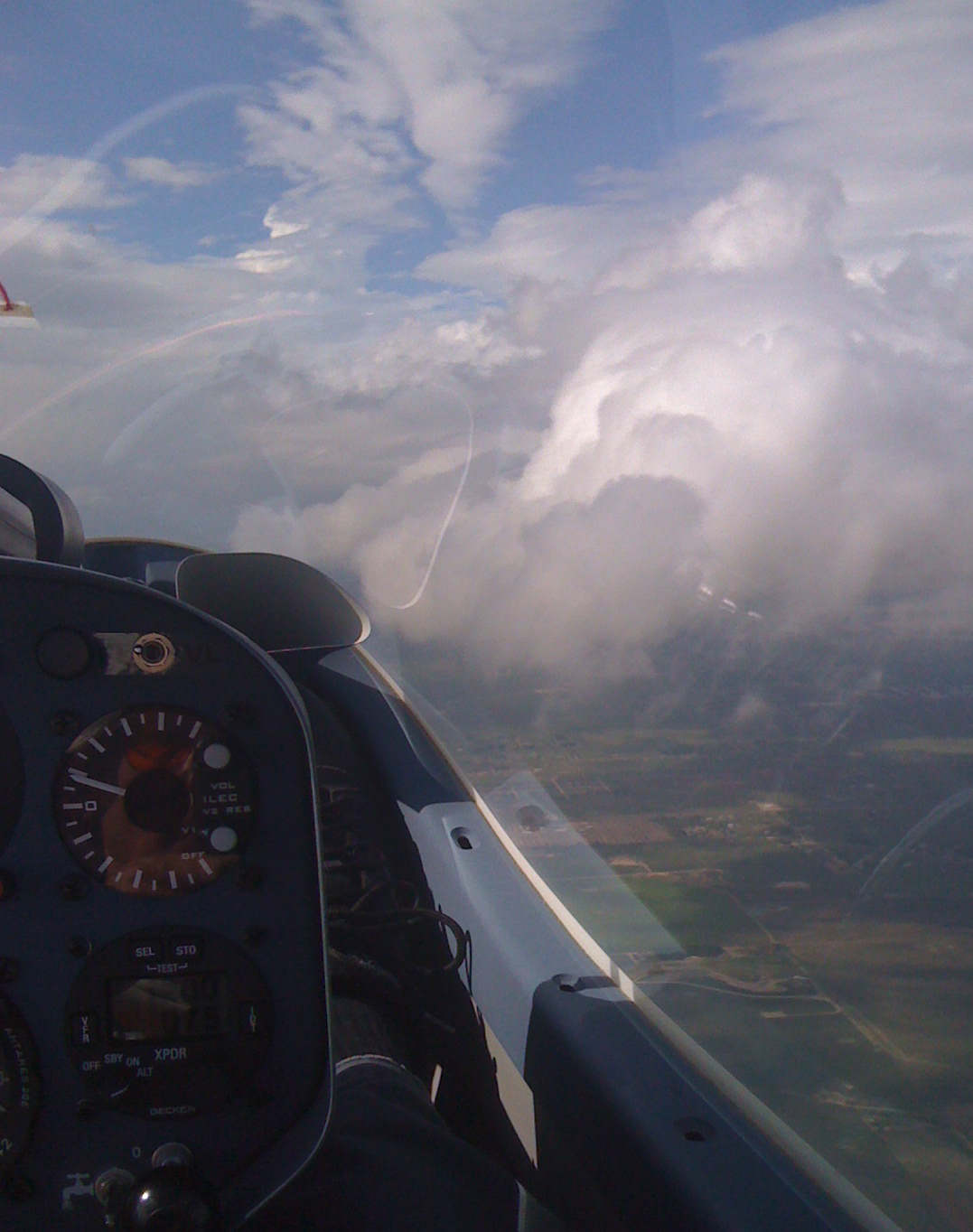
Returning to Hobbs. The big ramp was built as a WWII training
base and once hosted B-17s. The old hangars and barracks are
long gone, but the ramp still survives (barely).
Our main operations (launches and landings) are on the ramp.
Look carefully and you'll see a rainbow over the city of Hobbs.
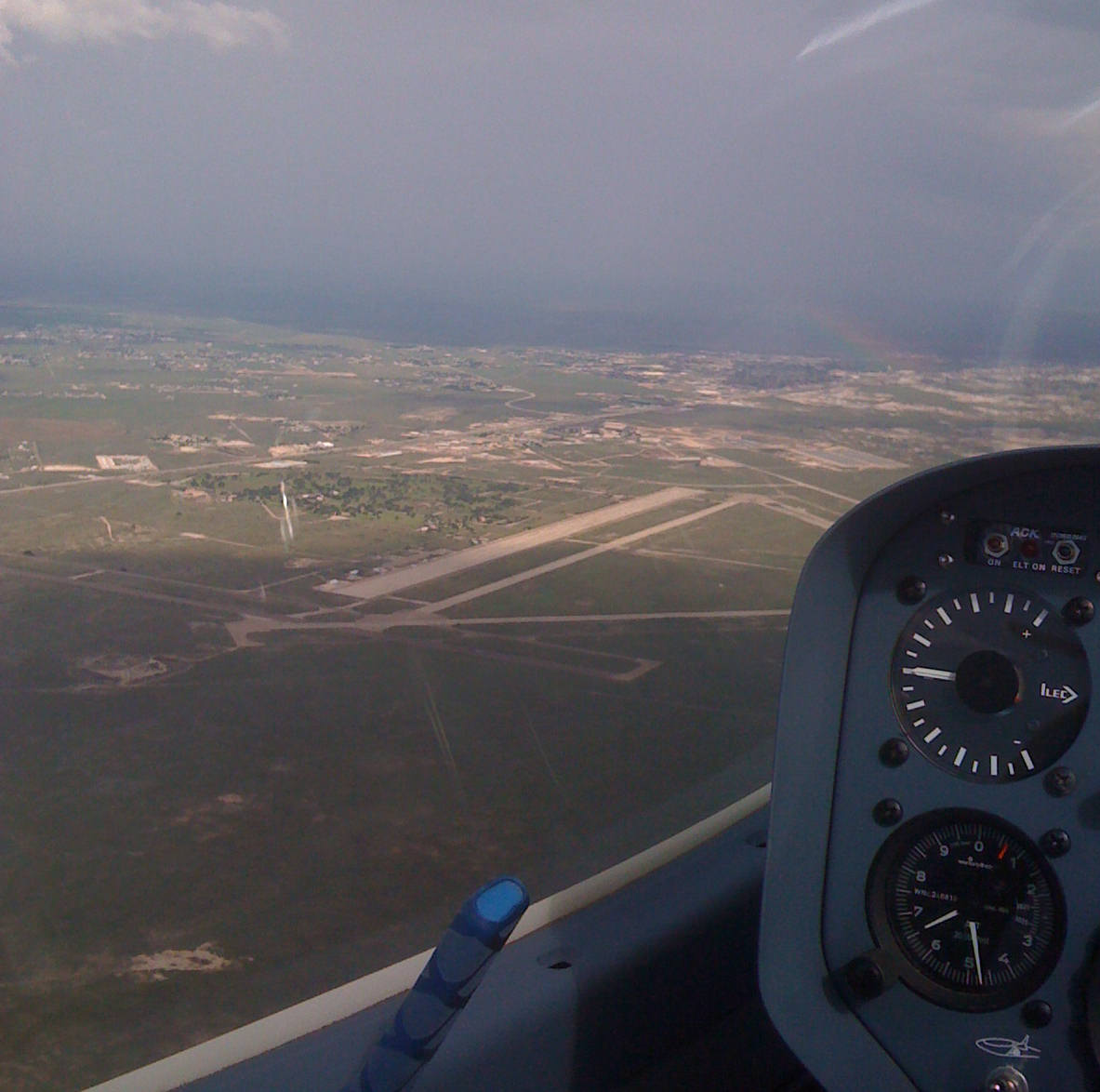
In standard class, Mark Keene and Dave Greenhill completed the task.
Ron Tabery was the sole finisher in open class, somehow threading the
storms. Other 17 starters landed out. Some hair-raising outlandings on
roads, oil-derrick pads and access roads, minor dings but nothing
serious. More later...
Standard class winner Mark Keene started within one minute of gate opening,
and found very tough going with no more than 2.5 knots under
great-looking clouds to Crossroads. Mark ran south along the same shelf
I did to the second turn (but 45 minutes earlier), and could see it was
going to blow up, just nicked the second cylinder, ran the shelf back
north just as it was blowing up into the second cylinder. He worked
back to Tatum, then found the convergence to run home. Mark also took
pictures of the convergence and showed them at the pilots briefing
Thursday.
Open winner Ron Tabery got hammered flying into the second cylinder
and noted a glideslope of 13:1 in the heavy rain, nicked the cylinder,
and headed back towards sunlight at Tatum. Finally got a thermal at 900
feet while looking at a road as a landing option, followed a couple
birds one of whom started flapping, followed a line of scruffy clouds
and gust front, eventually back to Tatum, then north a bit. Turned for
home, climbed again at Tatum, then found the convergence line for a
stress-free ride home (though Ron wasn't relaxed enough to take
pictures).
Thursday July 8
First thing this morning, the TV weather says 17 lightening strikes
in the past half hour in Hobbs. Its raining, flood watches in effect
for much of the area. Weatherman Walt Rogers apologized for yesterday's
"20% chance of thunderstorm" forecast. Today looks horrendous - very
moist airmass moving into the region. Grid time scheduled for 1PM,
don't assemble prior noon announcement.
There's been some discussion about whether we're going to have a valid contest. Here are the rules:
5.2.1.1 Minimum - For an Official competition, either of the following must be satisfied:
5.2.1.1.1 A sufficient number of entrants must have a final score not
less than 40% of the winner's final score. Unless otherwise specified
in Rule 6.12, this number shall be eight.
5.2.1.1.2 A minimum of five entrants with a current pilot ranking score
greater than 92.0 must have a final score not less than 75% of the
winner's final score.
In open class, pilot in 8th place has 45% of leader Ron Tabery's
score, so we're OK. Standard class needs a fourth day today which looks
really unlikely.
OK, day scrubbed at noon, weather hopeless.
Results
Official Results:
Open class: Ron Tabery wins open, Dick Butler second, Rick Walters 3rd, Brian Milner guest, Dave Nadler 4th, Gary Ittner 5th.
Standard class: no contest (only 3 days), Mark Keene in the lead, then Dave Greenhill.
Top 5 contestants in open class and standard leader Mark Keene flew with an
ILEC SN10B (this contest follows 18m winner Bill Elliot also flying
with ILEC SN10B) ;-) SN10 pilots especially like the new
version 2.35 area task features which make task planning easier (less
fiddling in the cockpit).
Epilogue
I hit the road mid-day Thursday (though sorry to miss the banquet)
as soon as the day was canceled, back home in Boston Saturday night
after 2200 miles on the road. Had a tire failure on the way home.
Remember to change your trailer tires every 3 years and use LT
(light-truck) tires, or you too could get to change a tire in the
middle of a Texas thunderstorm.
This was an incredibly difficult contest - made Ohio look like a
piece of cake. In Ohio we had weak slow flying, but completing the
tasks for many of us was never in doubt, and the landing options are
plentiful and low-stress. Hobbs at low altitudes is a bit different.
East over the Texas agricultural areas you have plenty of landing
options but reduced lift. Over the higher scrub terrain of the western
half of the task area, there's better lift but really sparse landing
options - not a problem at the heights we usually fly but really not
fun with a 3500 foot cloud base. Ron Tabery flew masterfully
(especially managing the storms the last day), as did Dick Butler
(winning the first three days).
Next adventure for me: EAA's 2010 AirVenture at Oshkosh, where I've
been invited back to fly the Antares 20E in the Oshkosh Airshow and
display it for the week. This is in support of EAA's focus on electric
aircraft, and to promote soaring and SSA to the quarter-million
aviation enthusiasts that attend this event. Last year's write-up here:
Participating
in
EAA's 2009 AirVenture Gathering at Oshkosh.
Hope you enjoy this and please email
with questions or comments,
Best Regards, Dave "YO"
Dave.Nadler@nadler.com
Links for more information...
Antares 20E
Electric Motorglider Information
Hobbs
contest
scores on SSA web site
Dave's
Soaring publications, including blogs from past contests
Copyright © 2010 - Dave Nadler - All Rights
Reserved













